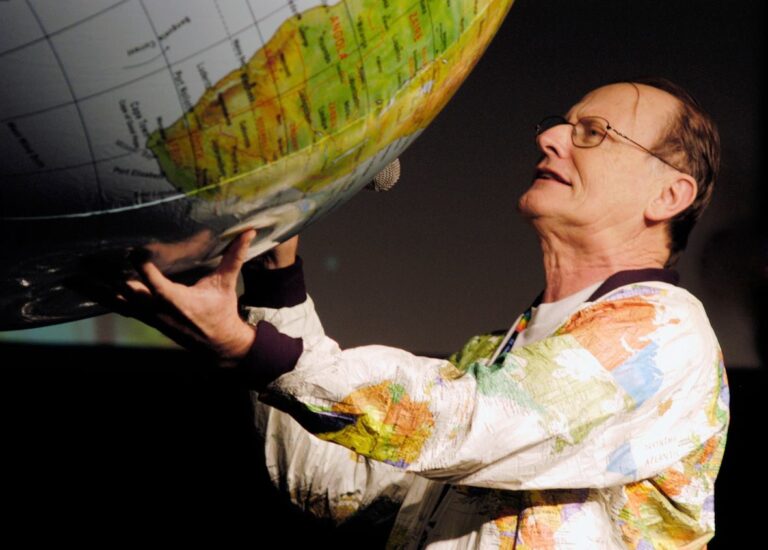Daniel Fuller died on June 21, 2023, at the age of 97.
In my 2015 doctoral dissertation at the Southern Baptist Theological Seminary on the four key influences on John Piper’s life and thought, I have a chapter dedicated to Fuller’s story and his influence.
One of the interesting things about Fuller’s early life is that two of his best friends, Bill Bright and Ralph Winter, would go on to become two of the most influential post-war evangelicals in the areas of evangelism and missiology. And three of them all started seminary education together.
Navigators and Bible Memorization
Daniel Payton Fuller was born on August 28, 1925, in Los Angeles, the only child of Charles E. Fuller (1887–1968) and Grace Payton Fuller (1886–1966).
In 1940 Dan Fuller met fellow South Pasadena High School freshman Ralph Winter (1924–2005), who quickly became his best friend.
The Winters had moved to South Pasadena from Highland Park, where they had recently left a fairly liberal Presbyterian church. They then joined Lake Avenue Congregational Church in Pasadena, where the Fullers had been members since 1933.
While in high school Fuller and Winter joined a Dunamis Club, the brainchild of Dawson Trotman (1906–1956), who had founded the Navigators in 1933. Around 1937 Trotman started these clubs in high school to encourage young men to study the Bible, to memorize Scripture, and to grow in effective witnessing. Fuller memorized hundreds of Bible passages during this time.
After graduating from South Pasadena High School in 1943, Fuller registered for the draft and enlisted in the Navy. He joined the new V-12 Navy College Training Program, where commissioned officers could receive expedited educational training. The Navy, anticipating an invasion of Japan and untold casualties, needed to replenish its commissioned officers. Fuller began his officer training at Occidental College in Los Angeles, and then eight months later was transferred to the University of California at Berkeley to train in the Naval ROTC.
On October 25, 1944, a 22-year-old Oklahoman named Bill Bright (1921–2003) arrived in Pasadena. Bright, a self-described “happy pagan,” had dreams of quick wealth, success in acting, and the start of a political career in Southern California. While driving around town that day, Bright picked up a hitchhiker, who happened to be a member of the Navigators. The hitchhiker took Bright to the home of Dawson Trotman, who invited him to spend the night.
That evening they went over to the Fuller house, where a party was being held in honor of Dan Fuller’s 19th birthday. Bright eventually began to attend the First Presbyterian Church of Hollywood—the largest Presbyterian church in the U.S. at the time—where he became a Christian during weekly Bible studies led by Henrietta Mears (1890–1963), the church’s influential director of Christian education.
Princeton Seminary and Inductive Bible Study
In September of 1946, following honorable discharge from the Navy as an ensign, Fuller was ordained as a Baptist minister and planned to enroll at Dallas Theological Seminary. But when Ralph Winter mentioned that he planned to go to Princeton Theological Seminary in New Jersey in order to learn the inductive method of studying the Bible, Fuller decided he would go to Princeton with his friend. Bill Bright joined them as well.
Winter and Bright would become roommates at Princeton, and Fuller and Bright would become close friends. Bright was an entrepreneur who had started a successful candy shop near the corner of Hollywood Boulevard and Vine Street. He had put a friend in charge of the candy business, but when the business began to fail, Bright needed to return to California to revive the work.
One of their teachers at Princeton was Howard T. Kuist (1895–1964), Charles T. Haley Professor of Biblical Theology for Teaching of English Bible, a pioneering advocate of the inductive Bible study method. Kuist emphasized the necessity of observation, defined as “the art of seeing things as they really are.” Preachers, he argued, have only a limited amount of time for sermon preparation, and therefore a majority of the preacher’s time should be spent in the text itself, not in secondary literature. Commentaries should be consulted only for facts, not conclusions. Kuist sought to convince his students to put aside all hermeneutical systems and presuppositions—including any sermon, creeds, or lesson they had heard before—and let the Bible speak for itself, as if they were approaching it for the first time. “Such talk,” Fuller recounts, “was a life-changing moment for me. I tend to construe my whole life since then as this idea’s playing a crucial role in what I did and how I thought thereafter.”
Kuist devoted the bulk of his classroom time “to coaching students in how to grasp an author’s intended meaning from the verbal symbols in a text.” The English Bible was their main text.
Kuist also had his students read two short readings. The first was Mortimer Adler’s chapter on “Coming to Terms” from How to Read a Book.
The second reading was a testimony from entomologist and paleontologist Samuel Scudder (1837–1911) about his student days in the classroom of Louis Agassiz (1807–1873), founder of the Harvard Museum of Comparative Zoology. Agassiz required his students to stare at a fish for hours on end, day after day, forbidding them to look at anything else or to use any artificial aids. “‘Look, look, look!’ was his repeated injunction.” When asked about his greatest accomplishment over his long career, Agassiz replied, “I have taught men to observe.” Fuller recounts, “This story produced a most profound change in my strategy for studying the Bible. It made me realize how diligently I must scrutinize a Bible passage to see just what is there and try to forget what I had previously heard or read about that passage.”
Kuist led his class through an inductive study of the Gospel of Luke, but the observation work was so intensive that they were only able to work through the first three chapters of the book. As they worked through the material, Fuller began to doubt some of what he had learned from the Scofield Bible, which was so influential in fundamentalist dispensationalism. Fuller was seeing the fallibility of his own theological tradition as he sought to study the Bible afresh.
Fuller thought that Kuist himself was a better advocate of this methodology than a model. But Kuist had imparted to Fuller an intensive observational methodology that was the seedbed of his own distinct method of inductively seeking the author’s intent by tracing the logical relationships in an argument while seeking to set all presuppositions and systems aside.
Fuller Seminary and the Rise of Neo-Evangelicalism
Not long after he arrived at Princeton, Fuller received a letter from his parents expressing their optimism about the long-term strategy of this educational investment, even though both of them feared its modernist influence upon their only son. Grace wrote, “Dad has felt that if you could come through Princeton . . . it would widen your field of influence and open many doors for you. . . . Dad feels that you would have his vision and carry on in his way to mold the school, possibly to teach there, and to keep it in the middle of the road.”
The “school” that she mentions was a longstanding dream of Charles Fuller’s. He had been awakened from sleep one night in November of 1939 with an “impression” to start a Christian college. Charles Fuller was a fundamentalist pastor and evangelist who hosted a weekly “Old Fashioned Revival Hour” radio program. He was not a theologian or an educator, but a mobilizer and influencer with longstanding connections to Christian higher education. Now he sensed the Lord calling him to begin a new work.
As Dan Fuller was completing his second semester at Princeton, Grace and Charles Fuller were having exploratory meetings about the college with Audrey and Harold John Ockenga. When Ockenga suggested that a seminary would be more strategic than an undergraduate institution, Mrs. Fuller wondered if there were enough qualified evangelicals to teach at such a school. Ockenga—who had a PhD from the University of Pittsburgh and knew the academic world well—rattled off a half dozen potential candidates. The Fullers were impressed, and the initial faculty was assembled by late spring of 1947.
In September of 1947, Dan Fuller, Ralph Winter, and Bill Bright were among the 39 students of the inaugural class of Fuller Theological Seminary.
The Evangelist, the Missiologist, and the Professor
These three men helped to shape post-war evangelicalism.
In 1951, Bright dropped out of Fuller Seminary in order to begin reaching out to college students at the University of California in Los Angeles, where he and his wife Vonette founded Campus Crusade for Christ (renamed Cru in 2011). In 1957, Bright published his widely influential evangelistic tract, “Have You Heard of the Four Spiritual Laws?”
In 1974, after a stint as a missionary and then serving as a professor for a decade at the new school of missions at Fuller Seminary, Winter changed the course of missiology with his talk at the Lausanne Congress on World Evangelization as he advocated that the church prioritize the reaching of unreached peoples (that is, socio-linguistic people groups), not just geo-political countries. Two years later, he and his wife Roberta founded the U.S. Center for World Mission to mobilize the reaching of unreached people groups.
Dan Fuller returned to Fuller Seminary in the fall of 1962 after earning his second doctorate, this time from the University of Basel, which led to a painful rupturing of the school especially over the issue of inerrancy. Though not widely published, his own contributions sought to critique both dispensationalism and covenant theology especially in the areas of law and gospel. His capstone class eventually became a book, The Unity of the Bible.
Fuller’s most influential student was John Piper (b. 1946), who studied at Fuller Seminary from 1968 to 1971 before going on to doctoral studies at the University of Munich. Though Piper and Fuller who eventually differ in important ways on some significant issues (egalitarianism, inerrancy, imputation, etc.), Piper never tired of expressing his gratitude to God for planting the seeds of Christian Hedonism and giving him a lifelong method for looking at the Book.
He once wrote: “I would let you cut off my hands and feet before I would let you take from me what I learned under the teaching of Daniel Fuller at Fuller Seminary. Not because I value the words of men, but because his words opened the Word for me like no one ever had.”
The evangelist. The missiologist. And the professor. And it all started when they decided to cross the country together to learn how to study the Bible inductively so they could more effectively reach people for Christ.


















